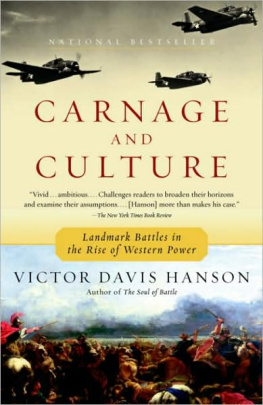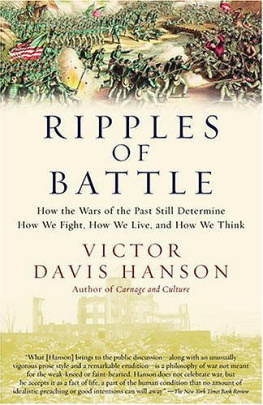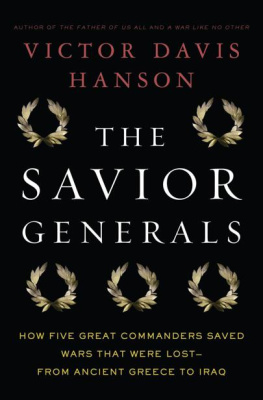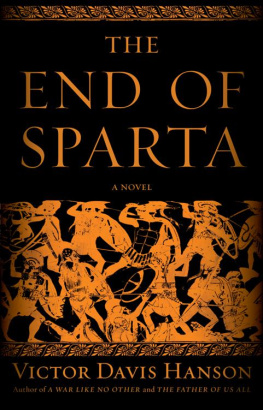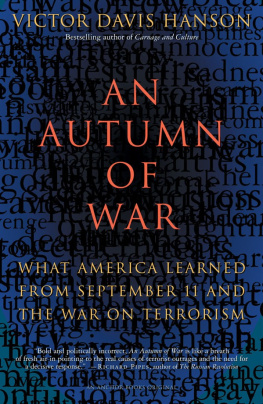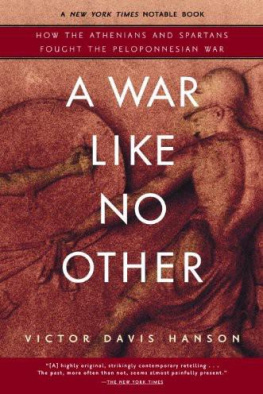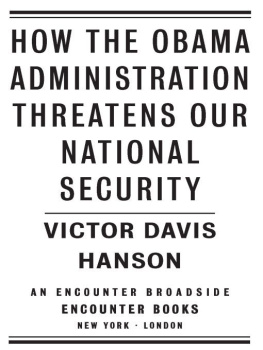Victor Davis Hanson - Carnage and Culture: Landmark Battles in the Rise to Western Power
Here you can read online Victor Davis Hanson - Carnage and Culture: Landmark Battles in the Rise to Western Power full text of the book (entire story) in english for free. Download pdf and epub, get meaning, cover and reviews about this ebook. year: 2009, publisher: Anchor Books, genre: Politics. Description of the work, (preface) as well as reviews are available. Best literature library LitArk.com created for fans of good reading and offers a wide selection of genres:
Romance novel
Science fiction
Adventure
Detective
Science
History
Home and family
Prose
Art
Politics
Computer
Non-fiction
Religion
Business
Children
Humor
Choose a favorite category and find really read worthwhile books. Enjoy immersion in the world of imagination, feel the emotions of the characters or learn something new for yourself, make an fascinating discovery.
- Book:Carnage and Culture: Landmark Battles in the Rise to Western Power
- Author:
- Publisher:Anchor Books
- Genre:
- Year:2009
- Rating:3 / 5
- Favourites:Add to favourites
- Your mark:
- 60
- 1
- 2
- 3
- 4
- 5
Carnage and Culture: Landmark Battles in the Rise to Western Power: summary, description and annotation
We offer to read an annotation, description, summary or preface (depends on what the author of the book "Carnage and Culture: Landmark Battles in the Rise to Western Power" wrote himself). If you haven't found the necessary information about the book — write in the comments, we will try to find it.
Carnage and Culture: Landmark Battles in the Rise to Western Power — read online for free the complete book (whole text) full work
Below is the text of the book, divided by pages. System saving the place of the last page read, allows you to conveniently read the book "Carnage and Culture: Landmark Battles in the Rise to Western Power" online for free, without having to search again every time where you left off. Put a bookmark, and you can go to the page where you finished reading at any time.
Font size:
Interval:
Bookmark:
Also by Victor Davis Hanson
Warfare and Agriculture in Classical Greece
The Western Way of War
Hoplites (editor)
The Other Greeks
Fields Without Dreams
Who Killed Homer? (with John Heath)
The Wars of the Ancient Greeks
The Soul of Battle
The Land Was Everything
Bonfire of the Humanities
(with John Heath and Brian Thornton)
An Autumn of War
AFTERWORD
Carnage and Culture after September 11, 2001
ABOUT THREE WEEKS after the hardcover publication of Carnage andCulture, terrorists killed nearly 3,000 Americans on the home soil of the United States. Less than a month later, on October 7, the United States responded with an air and ground assault against the suspects: the al Qaeda terrorist network and its sympathetic host government, the Islamic fundamentalists known as the Taliban of Afghanistan. Names, peoples, and places in Carnage and Culture that had once seemed distant and theoreticalAlexander the Great, armies of Islam, unfree Easterners, and Tet now seem to be immediate and real as we Americans read daily of Kandahar, jihad, burqas, and the so-called lessons of Vietnam.
In the epilogue of Carnage and Culture, I had suggested that the events of the last two decadesthe Falklands War, the ongoing fighting in Palestine, and the Gulf Warsupported the books thesis of some 2,500 years of general Western military superiority across time and space. The argument was not necessarily a moral one. Rather my point was that Western approaches to culture, politics, economics, and citizens rights and responsibilities gave European states and their offspring military power well beyond what their relatively modest populations and territories might otherwise suggest. Recent events of the past six moths have, like military conflicts of the last twenty years, again supported that thesis.
September 11, while not a battle in the classic sense of a Salamis or Lepanto where thousands of combatants fought to the death, was in its own way a landmark engagement. More Americans died on September 11, 2001, than during any assault on America in our history. The death toll in New York and Washington was far greater than at Lexington and Concord, the Alamo, Fort Sumter, Havana harbor, the seas off Ireland where the Lusitania sank, or Pearl Harborhistoric attacks that also triggered earlier American wars. More importantly, September 11 was not an aberration, but in some sense the culmination of a growing divide between the Islamic and Western worlds, and followed a series of earlier killings of Americans in Lebanon, Saudi Arabia, Somalia, Sudan, Yemen, and at the World Trade Center. The sheer number of American civilian dead, the growing anger at yet another unprovoked terrorist attack, and the apparent complicity of a number of sovereign states in the terrorists plots all released an outpouring of unprecedented American rage and prompted a military response of an intensity not seen since the Gulf War.
In less than ten weeks, the United States military removed the Taliban from power in Afghanistan. The Americans were faced with the logistical nightmare of fighting in a landlocked country 6,000 miles away, against terrorists and their hosts who enjoyed both internal and foreign support, and in a climate of growing tension between the Islamic and Western worlds. Despite these difficulties they routed their enemies, installed a consensual government in their place, and proceeded to wage war with their allies against terrorist cells throughout the globe in Afghanistan, Yemen, parts of the former Soviet Union, and the Philippines.
In the immediate aftermath of September 11, critics doubted that the United States could be successful either in Afghanistan or against an enemy as nebulous as the global terrorist cells. Rather than examining the lethal histories of Western armies of the past, skeptics of the present cited the harsh winters in the Asian subcontinent. They conjured up the bitter experiences of the Russians and British in Afghanistan, the ghosts of Vietnam, the ferocity of the terrorists, and the fanaticism of their Taliban supporters. Few found solace in the past success of Western nations at war, even when their traditional advantages were manifest in the immediate aftermath of the terrorist attacks on the World Trade Center in New York and the Pentagon in Washington, D.C.calm assemblies of our elected officials, passengers voting to attack the hijackers and sacrifice themselves to save thousands of others, massive yet spontaneous public support for the families of the deceased, and an almost immediate muster of vast American armed forces from nearly every region of the globe. Indeed, all the themes of Chapters One through Nine in Carnage andCulture became quickly apparent in the hours following the attack.
Unlike the responses of the 1980s and 1990s to distant terrorist attacks, when America reacted haphazardly and impotently to such aggression, this time the government of the United States responded promptly and dramatically to the crisis. It increased domestic security, authorized multifaceted attacks abroad, and tended to the loss of almost 3,000 Americans, ensuing economic recession, and a general sense of uncertainty worldwide. Although civil libertarians worried about the implementation of new protocols of domestic surveillancethe terrorists had operated as sleeper cells designed to blend in with the general American populationthe United States remained an open and free society whose liberty proved a far greater strength than a liability. Operation Enduring Freedom may have sounded simplistic to cynical critics, but it was, in fact, similar in tone and theme to the phrase chosen by Athenian sailors who rowed at Salamis, encouraging each other with cries of eleutheria!
Although Americans no longer embrace universal conscription (in a nation of 300 million people, such a draft might now entail an unnecessarily cumbersome army of 20 to 30 million youths), civic militarism was very much alive. Our pilots, Marines, and Special Forces were themselves highly motivated, disciplined, and especially lethal. Enlistees subject to military rights and responsibilities commensurate with their status as free citizens proved themselves to be more disciplinedand imaginative than forced draftees in the armies of the Taliban. Just as Roman armies rallied after the string of defeats culminating at Cannae, so too did the United States military appear more, not less, powerful after September 11.
While the terrorists preferred to fight an asymmetrical war of stealth, in which surprise attacks and sudden terror might enable a smaller power to neutralize the superior force of its much stronger adversary, the United States was nevertheless able to marshal its overwhelming firepowerespecially laser- and satellite-guided bombsto blast enemies in sheer rock caves high in mountain peaks. Like Alexander the Greats quest for decisive battle at Gaugamela, the Americans believed that the surest way of defeating the enemy was first to go directly to Afhanistan and identify the Taliban and al Qaeda forces, and then through air power, allied proxy forces, and specialist advisors hit them head-on, and kill as many as possible in direct confrontations.
Much attention was given to air power and its deadly use of smart bombs, which were able to destroy indivdual houses of the terrorists without wrecking the homes of the innocent. As in the war in Kosovo, the aerial campaign over Afghanistan proved that the Americans could strike at will without incurring a single pilot casualty to enemy fire. Yet, as the events of 2002 progressed, it also became clear that American ground troops were necessary to force terrorists out of their entrenchments, and that such infantry proved themselves on every occasion superior to their adversaries in close fighting. While we are no longer, like the classical Greeks or republican Romans, an agrarian nation of small landowners, the sheer vastness of the American middle class ensured that our infantrymen would be relatively well-educated, independent, and representative of the countrys popular culturerather than poor tribesmen, shanghaied recruits, or illiterate peasants. However simplistic it may sound, thirteen centuries after Poitiers, Western infantrymen were once again fighting warriors who identified themselves as emissaries of Islam.
Next pageFont size:
Interval:
Bookmark:
Similar books «Carnage and Culture: Landmark Battles in the Rise to Western Power»
Look at similar books to Carnage and Culture: Landmark Battles in the Rise to Western Power. We have selected literature similar in name and meaning in the hope of providing readers with more options to find new, interesting, not yet read works.
Discussion, reviews of the book Carnage and Culture: Landmark Battles in the Rise to Western Power and just readers' own opinions. Leave your comments, write what you think about the work, its meaning or the main characters. Specify what exactly you liked and what you didn't like, and why you think so.

